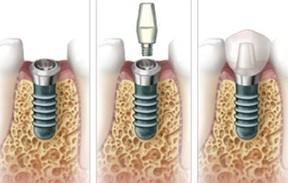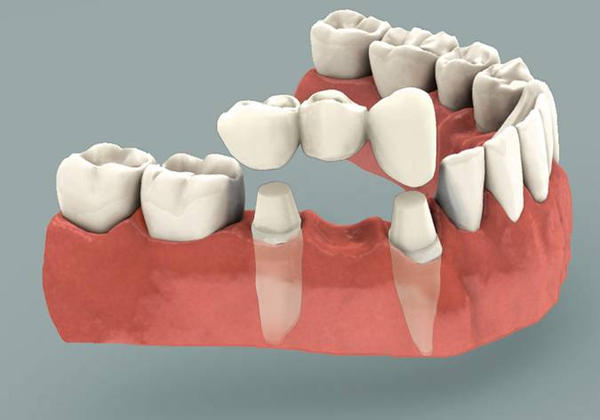Dental Implants
What are dental implants?
Dental implants are designed to provide a solution that looks, feels, and functions like natural teeth. People with dental implants regain the ability to eat virtually anything and can smile with confidence, knowing that their teeth look like real teeth. In addition, implants can help preserve facial structure, preventing the bone deterioration that occurs when teeth are missing.
Dental implants may be an option for people who have lost a tooth or teeth due to gum disease, an injury, or some other reason. A dental implant is an artificial tooth root that is placed into your jaw to hold a replacement tooth or bridge. It is usually a small post made of titanium and acts as the tooth root. This acts as a strong foundation for the replacement tooth.

Advantages of Dental Implants
- Improved appearance and self-confidence – Dental implants are permanent. They look and feel like your own teeth. You won’t feel uncomfortable in public or embarrassed to smile. Over time, a face without teeth can sag and look sad. Dental implants allow you to maintain your natural face shape and smile.
- Improved speech – Poor-fitting dentures can slip and make it hard to speak. Dental implants will feel like your own teeth so they will make every day conversations that much easier.
- Comfortable – Unlike removable dentures, dental implants become a part of you. They won’t slip out of place or need to be repositioned. You won’t even know they’re there.
- Eat your favourite foods – Unlike sliding dentures, dental implants function as your own teeth. You can bite naturally and eat your favourite foods comfortably and without pain.
- Strength – When placed properly and with good care, dental implants have the potential to last a lifetime.
- Convenience - Removable dentures are just that; removable. Dental implants eliminate the embarrassing inconvenience of removing dentures, as well as the need for messy adhesives to keep them in place.
- Oral Hygiene - Individual implants also allow easier access between teeth, improving oral hygiene.
What to expect during the procedure
The dentist places the dental implant underneath the gums and into the jaw bone. This will act like the tooth’s root. The gums are then stitched back together. As the jawbone heals, it grows around the implant, securing it into place. This process can take approximately 2-3 months.
The dentist then attaches a metal connector piece called an abutment to the implant. This connects the implant to the artificial tooth, holding the tooth securely in place.
To make a new tooth or teeth, the dentist will take impressions of your teeth. At Riverpark, we take digital impressions with an intra-oral camera to make this experience as comfortable for you as possible. It’s a little camera that takes many detailed pictures of your mouth and makes a computer-generated copy of your mouth.
An artificial tooth is made in a dental lab. The artificial tooth is called a crown. It is then attached to the abutment.
If multiple teeth in a row are missing, a patient may wish to get a bridge. In this case, two implants are placed on the two end teeth and the missing tooth/teeth in between are attached to them and joined like a bridge.
Replacing Several Teeth

If you are missing several teeth, implant-supported bridges can replace them. In additional to looking and functioning like natural teeth, implant-supported bridges replace teeth without support from surrounding natural teeth. This means that the teeth surrounding the implant-supported bridge will remain untouched.
Other common treatments for the loss of several teeth include fixed bridges or removable partial dentures. These treatments depend on support from surrounding teeth. Implant-supported bridges do not. This is beneficial for patients because the surrounding teeth remain intact and untouched.
Also, because implant-supported bridges replace some of your tooth roots, the bone underneath is better preserved and less will be resorbed by your body over time. Dental implants integrate with your jaw bone and help to keep the surrounding bone healthy and intact.
With a fixed bridge or removable partial denture, the gums and bone can recede around it. Resorbed bone underneath bridges or removable partial dentures can result in a collapsed, unattractive smile. The cement that holds the bridges in place can also wash out. This allows bacteria to decay the teeth that anchor the bridge in place.
Therefore, implant-supported bridges are a better, more permanent option for those missing multiple teeth.
How successful are implants?
Success rates of dental implants vary, depending on multiple factors such as where in the jaw the implants are placed, the patient's medical history, and other chewing factors; however, in general, dental implants have a success rate of up to 95-97%. With proper care, many implants can last a lifetime.
Risks
While implants are over 95% successful, the most important risks to be aware of are: infection, implant rejection, persistent numbness, and pain. We suggest that you come for a consultation with Dr. Inger to learn more about dental implants, the risks, challenges and the benefits.











